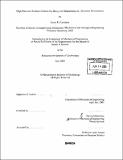High-precision position control of a heavy-lift manipulator in a dynamic environment
Author(s)
Garretson, Justin R. (Justin Richard)
DownloadFull printable version (3.863Mb)
Other Contributors
Massachusetts Institute of Technology. Dept. of Mechanical Engineering.
Advisor
Steven Dubowsky.
Terms of use
Metadata
Show full item recordAbstract
This thesis considers the control of a heavy-lift serial manipulator operating on the deck of a large ocean vessel. This application presents a unique challenge for high- precision control because the system must contend with both high levels of joint friction and oscillatory motions in the manipulator's base. Due to the uncontrolled outdoor environment, the behavior of these disturbances in the field cannot be accurately predicted using models developed offline. To achieve high-precision control, the system must therefore be capable of effectively estimating and compensating for these disturbances online. This thesis presents the design of a position control system to allow high-precision control of the manipulator's payload by a human user. The design features a standard decentralized linear control architecture augmented by a combination of adaptive and sensor-based techniques to estimate and compensate for base-motions and joint friction. A procedure is also suggested by which a parametric friction model can be extracted from adaptive estimates recorded over a period of time. This extracted model can be used to temporarily replace the adaptive estimation in compensating for joint friction when the manipulator is in contact with the environment. Performance of the control methods developed here are evaluated using simulation studies conducted with a high-fidelity dynamic model of the mechanical system. These studies demonstrate the tracking capability of the control system for various representative tasks.
Description
Thesis (S.M.)--Massachusetts Institute of Technology, Dept. of Mechanical Engineering, June 2005. "June 2005." Includes bibliographical references (leaves 81-83).
Date issued
2005Department
Massachusetts Institute of Technology. Department of Mechanical EngineeringPublisher
Massachusetts Institute of Technology
Keywords
Mechanical Engineering.